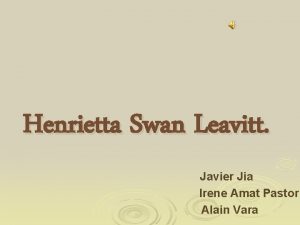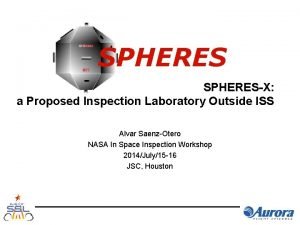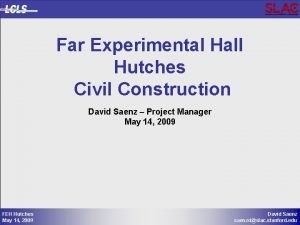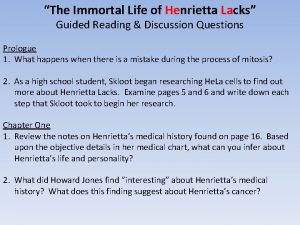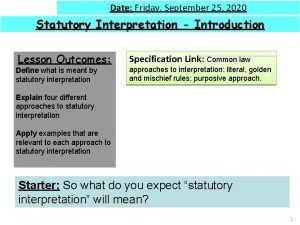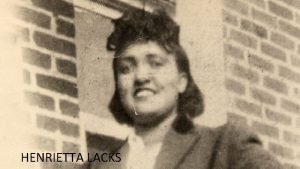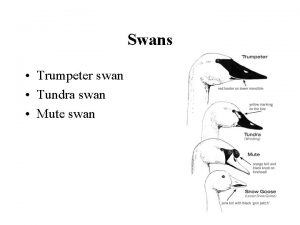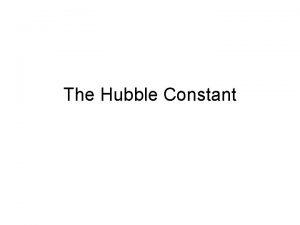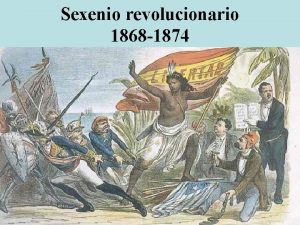HENRIETTA SWAN LEAVITT 1868 1921 Celine Saenz LIFE









- Slides: 9

HENRIETTA SWAN LEAVITT 1868 – 1921 Celine Saenz

LIFE • Born: 4 -Jul-1868 • Birthplace: Lancaster, MA • Died: 12 -Dec-1921 • Location of death: Cambridge, MA • Cause of death: Cancer - Stomach • Remains: Buried, Cambridge Cemetery, Cambridge, MA • Religion: Congregationalist • Occupation: Astronomer

EARLY LIFE • Daughter of George Roswell Leavitt and Henrietta Swan Kendrick • Sister: Mira Leavitt • Brother: Roswell Leavitt • Moved to Cleveland Ohio as a child • Attended Oberlin College in 1885 • Graduated in 1892 from the Society for the Collegiate Instruction for Women • Modern day Radcliffe College • After college, Leavitt lost her hearing while traveling through America and Europe

CAREER • Became a volunteer research assistant at Harvard College Observatory under the astronomer Edward Pickering • • Paid 30¢ an hour In 1908 she published her results in the Annals of the Astronomical Observatory of Harvard College noting that a few of the variables showed a pattern • She confirmed in 1912 • That the Cepheid variables with greater intrinsic luminosity did have longer periods • That the relationship was quite close and predictable Researching the measurement of stellar magnitudes After 17 years, Swan was hired as a permanent staff member • • • Brighter ones appeared to have longer periods • Her discovery is known as the "period-luminosity relationship“ • Discovered 1, 777 variable stars in the Magellanic Clouds

ACHIEVEMENTS A member of • Phi Beta Kappa • The American Association of University Women • The American Astronomical and Astrophysical Society • • The American Association for the Advancement of Science An honorary member of the American Association of Variable Star Observers Publications • "Periods of 25 Variable Stars in the Small Magellanic Cloud, " Harvard College Observatory Circular 173 (1912). • "Standard Photographic Magnitudes, " Science 30: 726 (1909). • "1777 Variables in the Magellanic Clouds", Annals of Harvard College Observatory 15: 87 (1908)

DEATH • Died of stomach cancer in 1921 at age fifty-three • Buried in the Leavitt family plot at Cambridge Cemetery in Cambridge, Massachusetts. • The asteroid 5383 Leavitt and the crater Leavitt on the Moon are named after her to honor deaf men and women who have worked as astronomers. • "If Henrietta Leavitt had provided the key to determine the size of the cosmos, then it was Edwin Powell Hubble who inserted it in the lock and provided the observations that allowed it to be turned, " wrote David H. and Matthew D. H. Clark in their book Measuring the Cosmos. • Edwin Hubble himself often said that Leavitt deserved the Nobel Prize for her work • Gösta Mittag-Leffler of the Swedish Academy of Sciences tried to nominate her for that prize in 1924 but she had died

“Miss Leavitt inherited, in a somewhat chastened form, the stern virtues of her puritan ancestors. She took life seriously. Her sense of duty, justice, and loyalty was strong. For light amusements she appeared to care little. She was a devoted member of her intimate family circle, unselfishly considerate in her friendships, steadfastly loyal to her principles, and deeply conscientious and sincere in her attachment to her religion and church. She had the happy faculty of appreciating all that was worthy and lovable in others, and was possessed of a nature so full of sunshine that, to her, all of life became beautiful and full of meaning. ” Written obituary of Henrietta Swan Leavitt by Solon Bailey

MISS LEAVITT'S STARS “Well, imagine this room full of these women, you know, most of them with their hair up in buns and their dresses buttoned up to the collars, a very Victorian scene. And they're all sitting in this room, and each one is staring at a glass photographic plate. And they're scrutinizing it, trying to measure the brightness of these stars, writing down the numbers in fountain pen in a ledger, doing these calculations. And in the midst of all this, suddenly Henrietta Leavitt notices this pattern; that some of these stars vary in brightness. They pulse like beacons, so every 30 days they go from dim to bright to dim again. And she was studying these variable stars when she suddenly noticed that the brighter the star, the slower it blinked. She figured out that how fast the star was blinking told her how bright it really was. And if you know how bright it really is, you can see how dim it appears to you from the distance of space, and then you can calculate how far away it is. ” George Johnson author of Miss Leavitt's Stars: The Untold Story of the Woman Who Discovered How to Measure the Universe

WORKS CITED • http: //www. npr. org/templates/story. php? story. Id=4738071 • http: //www. nndb. com/people/047/000170534/ • http: //www. famousscientists. org/henriettaswan-leavitt/ • http: //www. aas. org/cswa/status/2005/JANUAR Y 2005/Henrietta. Leavitt. html • http: //www. physics. ucla. edu/~cwp/Phase 2/Lea vitt%2 c_Henrietta_Swan%40871234567. html • http: //www. womanastronomer. com/hleavitt. ht m • http: //chicagoacs. net/WCC/leavitt. html • Miss Leavitt's Stars: The Untold Story of the Woman Who Discovered How to Measure the Universe by George Johnson • http: //www. 3 towers. com/sgrasslands/essays/le avitt/Leavitt 01. asp

